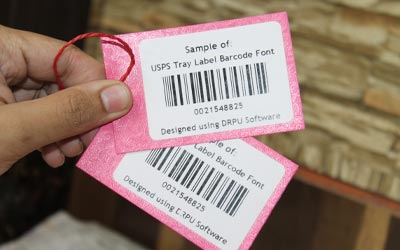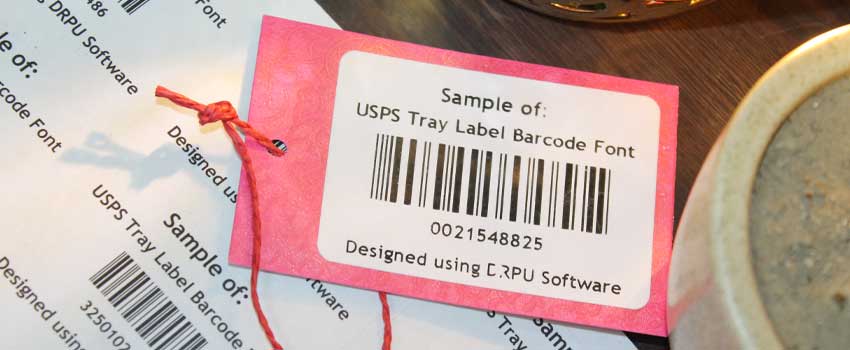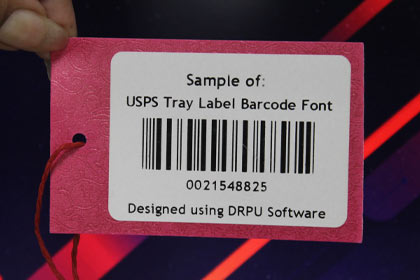USPS Tray Label Barcode
These barcodes are printed on labels that are affixed to the outside of the trays, and they contain information about the contents of the tray, as well as routing and sorting information.The system uses advanced scanning and tracking technologies to ensure that mail is sorted and delivered quickly and accurately, while also providing customers with real-time information about the status of their mail.
🞛 To generate a USPS tray label barcode, mailers must use approved software or online tools to create a barcode that complies with USPS specifications. The barcode contains several elements, including the Mailer ID, Tray ID, and Mail Processing Category. The Mailer ID is a unique identifier assigned to the mailer by the USPS, and it is used to track the origin of the mail. The Tray ID is a unique identifier assigned to the tray by the mailer, and it is used to identify the contents of the tray. The Mail Processing Category indicates the type of mail being shipped, such as First-Class Mail, Standard Mail, or Priority Mail.
🞛 Once the barcode is generated, it is printed on a label using a compatible printer. The label is then affixed to the outside of the mail tray in a specific location specified by the USPS. The tray is then scanned at various points throughout the mail processing and delivery process to track its movement and ensure that it is delivered to the correct destination.
🞛 Overall, the USPS tray label barcode system is an important component of the USPS's efforts to improve the efficiency and accuracy of mail processing and delivery. By using advanced scanning and tracking technologies, the USPS can ensure that mail is sorted and delivered quickly and accurately, while also providing customers with real-time information about the status of their mail. If you are a mailer who frequently sends large volumes of mail, the USPS tray label barcode system may be a valuable tool to consider.
USPS Tray Label Barcode Different from Other Barcode Types
The USPS tray label barcode is a unique barcode type that is specifically designed for use by the United States Postal Service (USPS). While there are many different types of barcodes used in various industries, the USPS tray label barcode has several distinct features that set it apart from other barcode types. These features include:
-
Unique
Structure :
The USPS tray label barcode has a unique structure that is designed to convey specific information about the contents of the mail tray. The barcode contains a series of data elements, including the Mailer ID, Service Type ID, Mail Processing Category, and Destination ZIP Code, among others. These elements are arranged in a specific format that is unique to the USPS tray label barcode.
-
Advanced Encoding :
The USPS tray label barcode also uses advanced encoding techniques to ensure that the barcode can be read accurately and efficiently by barcode scanners. The barcode uses a combination of variable-width bars and spaces, as well as special encoding techniques, such as start and stop characters and check digits, to ensure that the barcode can be read reliably.
-
Larger Size
:
The USPS tray label barcode is also larger in size than many other barcode types. The barcode is designed to be printed on a label that is affixed to the mail tray, and it must be large enough to be easily scanned by barcode readers. As a result, the USPS tray label barcode is typically larger than other barcodes used in various industries such as retail, manufacturing, or healthcare.
-
Limited
Usage :
Another key difference between the USPS tray label barcode and other barcode types is that the USPS tray label barcode has a limited usage. While other barcodes may be used for a wide range of applications, the USPS tray label barcode is specifically designed for use by the USPS for the sorting and tracking of mail trays. As a result, the barcode is not used in other industries or applications.
-
Unique
Identification :
The USPS tray label barcode also provides a unique identification for each mail tray. The barcode contains information about the contents of the tray, as well as routing and sorting information, which allows the USPS to quickly and accurately sort and deliver mail. This unique identification also enables customers to track their mail in real-time, providing greater visibility and transparency throughout the delivery process.
-
Integration with USPS
Systems :
Finally, the USPS tray label barcode is designed to integrate seamlessly with USPS systems and processes. The barcode is used in conjunction with other USPS technologies, such as Intelligent Mail barcodes and automated sorting equipment, to ensure that mail is processed quickly and efficiently. This integration with USPS systems and processes is a key feature that sets the USPS tray label barcode apart from other barcode types.
In summary, the USPS tray label barcode is a unique barcode type that is specifically designed for use by the USPS. The barcode has a distinct structure and uses advanced encoding techniques to ensure accuracy and reliability. The barcode is also larger than other barcode types and has a limited usage, being used only for sorting and tracking mail trays. The USPS tray label barcode provides a unique identification for each mail tray and integrates seamlessly with USPS systems and processes, making it a key component of the postal system's operations.
Structure Of USPS Tray Label Barcode

The structure of a USPS tray label barcode is a specific format of a barcode that is used by the United States Postal Service (USPS) to identify and track mail trays that contain letters, flats, and parcels. These barcodes are printed on labels that are affixed to the outside of the trays, and they contain information about the contents of the tray, as well as routing and sorting information.
The USPS tray label barcode consists of several elements that are encoded in a specific sequence. The barcode is a 4-state barcode, meaning that it can represent four different values using two bars and two spaces. The barcode is divided into three sections: the start character, the data characters, and the stop character.
-
Start Character:
The start character of a USPS tray label barcode is always an asterisk symbol (*). This character is used to indicate the beginning of the barcode and is necessary for the barcode reader to know where the barcode begins.
-
Data Characters :
The data characters of a USPS tray label barcode contain the information necessary to identify the tray and its contents. The data characters are divided into several elements, including the Mailer ID, the Tray ID, and the Mail Processing Category.
-
Mailer ID :
The Mailer ID is a unique identifier assigned to the mailer by the USPS, and it is used to track the origin of the mail. The Mailer ID is six digits long and is represented in the barcode using a combination of bars and spaces.
-
Tray ID :
The Tray ID is a unique identifier assigned to the tray by the mailer, and it is used to identify the contents of the tray. The Tray ID is up to 11 characters long and can include letters, numbers, and some special characters. The Tray ID is represented in the barcode using a combination of bars and spaces.
-
Mail Processing
Category :
The Mail Processing Category indicates the type of mail being shipped, such as First-Class Mail, Standard Mail, or Priority Mail. The Mail Processing Category is represented in the barcode using a combination of bars and spaces.
-
Stop Character :
The stop character of a USPS tray label barcode is always a vertical bar symbol (|). This character is used to indicate the end of the barcode and is necessary for the barcode reader to know where the barcode ends.
Conclusion:The structure of a USPS tray label barcode is designed to be easily read by barcode readers, which can quickly scan and decode the barcode to obtain the information necessary to route and sort the mail. By using advanced scanning and tracking technologies, the USPS can ensure that mail is sorted and delivered quickly and accurately, while also providing customers with real-time information about the status of their mail.
Minimum and Maximum Length USPS Tray Label Barcode
The data elements that make up the USPS tray label barcode vary depending on the type of mail being processed and the specific requirements of the USPS. However, they typically include information such as the Mailer ID, Service Type ID, Mail Processing Category, and Destination ZIP Code, among others.
The USPS has established specific guidelines for the minimum and maximum length of the tray label barcode. These guidelines are designed to ensure that the barcode is large enough to be easily read by barcode scanners, while also being compact enough to fit on the label that is affixed to the mail tray.
The minimum length of the USPS tray label barcode is 22 digits. This includes the start and stop characters, as well as the data elements that make up the complete barcode. The start and stop characters are always the same for the tray label barcode and are represented by the characters < and>, respectively.
The United States Postal Service (USPS) tray label barcode is a type of barcode that is used to identify and track mail trays as they move through the postal system. The barcode is printed on a label that is affixed to the outside of the mail tray, and it contains information about the contents, routing as well as sorting information.USPS system, leading to faster and more efficient delivery of mail.
The maximum length of the USPS tray label barcode is 31 digits. This includes the start and stop characters, as well as the data elements that make up the barcode. Barcode is determined by the size of the label that is affixed to the mail tray. The label must be large enough to accommodate the barcode, but it cannot be so large that it interferes with other postal markings or makes the mail tray difficult to handle.
In addition to the minimum and maximum length requirements, the USPS tray label barcode must also meet other technical specifications. For example, the barcode must be printed using a high-resolution printer to ensure that the barcode is clear and easily readable by scanners. The barcode must also be printed using black ink on a white background to provide maximum visibility.
Conclusion: Overall, the minimum and maximum length requirements for the USPS tray label barcode are designed to ensure that the barcode is easily readable and that it fits within the constraints of the mail tray label. By adhering to these requirements, mailers can ensure that their mail trays are properly identified and tracked as they move
Print USPS Tray Label Barcode
Printing a USPS tray label barcode is a crucial step in preparing a tray of mail for shipment. Here are the steps to print a USPS tray label barcode:

1Obtain the tray label: Before printing a USPS tray label barcode, you must first obtain the tray label. This label contains important information about the tray of mail, including the USPS facility ID, tray type, and tray number. You can obtain the tray label from the USPS website or from a local USPS facility.
2Choose a printer : The next step is to choose a printer that is compatible with the label stock and can produce high-quality barcodes. Laser printers or thermal printers are typically the best options for printing USPS tray label barcodes. Make sure that the printer is set up and ready to print before proceeding.
3Select the correct label size and orientation : USPS tray labels come in several sizes, depending on the size of the tray and the type of mail being shipped. Ensure that you select the correct label size and orientation for your tray label barcode. If necessary, adjust the printer settings to match the label size and orientation.
4 Load label stock into the printer : Load the appropriate label stock into the printer, ensuring that the labels are facing the correct direction and that the printer is set up to print on the label stock.
5 Print the tray label barcode : Using the tray label barcode file generated in a specialized software or online tool, print the tray label barcode on the label stock. Verify that the barcode is printed clearly and accurately, and that it meets USPS specifications.
6 Affix the tray label to the tray : After printing the tray label barcode, affix the label to the tray according to USPS guidelines. Ensure that the barcode is placed in the correct location and is not obscured by any other labels or markings.
Conclusion:In summary, printing a USPS tray label barcode requires obtaining the tray label, choosing a compatible printer, selecting the correct label size and orientation, loading the label stock, printing the barcode, and affixing the label to the tray according to USPS guidelines.
Characters Can Be Encoded USPS Tray Label Barcode
🔷 The USPS tray label barcode uses the Code 128 barcode symbology, which can encode a wide range of characters, including uppercase letters, lowercase letters, numbers, and various symbols. In addition, the Code 128 symbology includes special characters that are used to control the structure and formatting of the barcode.
🔷 The USPS tray label barcode consists of a series of data elements that are encoded using the Code 128 symbology. These data elements are used to identify the mail tray and provide information about its contents and destination.
🔷 The specific characters that can be encoded in a USPS tray label barcode depend on the data element being encoded. For example, the Mailer ID data element consists of a six-digit number that uniquely identifies the mailer. This data element can be encoded using the characters 0-9.
🔷 The Service Type ID data element consists of a three-digit code that identifies the type of service being used, such as Priority Mail or First-Class Mail. This data element can be encoded using a combination of uppercase letters and numbers.
🔷 The Mail Processing Category data element consists of a one-digit code that identifies the type of mail being processed, such as letters, flats, or parcels. This data element can be encoded using the numbers 0-9. The Destination ZIP Code data element consists of a five-digit or nine-digit ZIP code that identifies the destination of the mail. This data element can be encoded using the numbers 0-9.
🔷 In addition to these data elements, the USPS tray label barcode can also include special characters that are used to control the structure and formatting of the barcode. For example, the start and stop characters "<" and ">" are used to indicate the beginning and end of the barcode. The FNC1 character is used to indicate the presence of an Application Identifier (AI), which is a special code used to identify specific data elements within the barcode.
Conclusion:Overall, the USPS tray label barcode can encode a wide range of characters, including uppercase letters, lowercase letters, numbers, and various symbols. This flexibility allows mailers to encode a variety of information about the contents of their mail trays, leading to faster and more efficient processing and delivery of mail.
